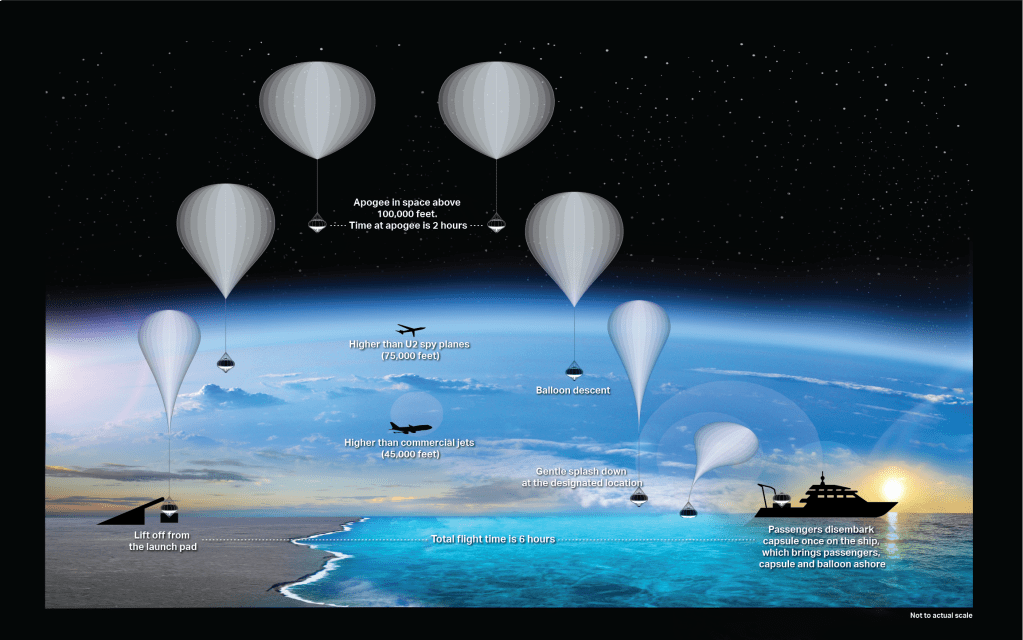After a long hiatus, space tourism came back this year. The last trip was in 2012 to the ISS, but there have recently been four trips: two sub-orbital flights by Blue Origin in July and October, one by Virgin Galactic in July, and a four-day orbital jaunt by Inspiration 4 in a Falcon 9 in September:

The trips came in for much mockery and disdain, but I think for the wrong reasons. Let me describe those, and then talk about a better way to experience the main pleasure of this kind of travel – the awesome and inspirational view of the Earth from above.
First off, yes, the New Shepard rocket does look like a penis, and no, that’s not deliberate. That’s just the shape you get when you put a large capsule on a small rocket. The rocket is small because it needs to be cheap, and the capsule is large so that its passengers aren’t mashed on top of one another. Yes, Blue Origin is competing with SpaceX, but they’re not doing it with shapes that you see on bathroom walls. Its owner, Jeff Bezos, wants to get people excited about space again, and he figures the way to do that is to let people go there themselves. The very name Blue Origin comes from his belief that the Earth is our birthplace, but not our only home in the long run. SpaceX is taking a strictly economic approach by trying to make space as cheap as possible, and that works too. Note that the Falcon 9 is far bigger than the New Shepard, and that’s because it’s a genuine orbital rocket, not a sub-orbital hopper.
Second, yes, these trips are expensive, but it’s not much for the people involved. The sub-orbitals cost a few million, which is in the noise to billionaires like Bezos and Richard Branson (the owner of Virgin Galactic). Actually funding these companies has cost the two of them billions, but really, what else do they have to spend it on? Another cruise-ship-sized yacht? That doesn’t get you points with the club members.
The same goes for Jared Isaacman, who purchased the Inspiration 4 flight. He’s the CEO of Shift4, a company that manages credit card sales for small businesses. They do about $500M a year in gross sales with about $100M in profit. His share of the public company is estimated at $2.4B. This trip probably cost him $200M, plus he says he’ll donate $100M to a charity, St. Jude Children’s Hospital in Memphis. Aircraft are his hobby – he set the record for a round-the-world trip in a light jet, about 62 hours. He also has a company, Draken International, that has 70 fighter jets, largely foreign (E.g. MIGs), that it flies for the Air Force as opposition aircraft for training. That’s a bit sinister. This flight is a visible chunk of his net worth, but he still won’t miss it.
Third, the environmental impact of this stuff is minor. The CO2 emissions of even the largest of them, the SpaceX launch, is similar to that of a ten-hour 747 flight (about 350 tonnes), and dozens of those happen every day. All three of these vehicles are re-usable, so they’re not spreading junk all over the ocean floor as previous rockets did.
No, the real problem with these trips is that they’re crummy outings. The sub-orbitals are only 10 minutes long. In that time you get to spend a few minutes floating around in zero-gee and looking out the windows, and then they you’re done. It’s pretty much a long roller coaster ride at a million times the price.
The orbital trip has the opposite problem – it’s way too long. You’re stuck in a space the size of a bathroom with three other people for four days. You have to deal with bad food, space sickness, difficult toilets, and the interesting smells and personality quirks of your fellow travelers.
So a far better way to do this is by high-altitude balloon:

There are several firms looking to offer this, but the furthest ahead is Space Perspective. They’re actually based on Cape Canaveral. They plan to offer 6-hour flights for $125,000 – two hours to get up to 100,000 feet (30 km), two hours to admire the incredible view, and two hours descending as the balloon deflates, and then a splashdown in the Atlantic:

They will launch before dawn, so you’ll see sunrise over the ocean. The capsule holds eight passengers, a pilot, and a bar, with a restroom below. The balloon is 200 m tall on the ground, twice the height of the Saturn V, and inflates to 15 million m3 at altitude, where it is about 200 m across.
The company has a lot of experience with balloons. They built the system that Alan Eustace used in his record-setting skydive from 136,000 feet (41 km) in 2014. Many of them were involved in the NASA super-pressure balloon program, a terrific program that I wrote about here: How Space Science Might Have Gone. The capsule manufacturing head comes from SpaceX, and has experience in luxury yacht design, which sounds like what you want for that much money.
An unmanned test happened in June 2021, and was successful. Full-up tests should happen in 2023, and first paying flights in 2024. Passengers need no training and have no health requirements beyond those needed to fly. You walk on, rise gently up, and get to see this with a drink in hand:

This is what William Shatner was inspired by on his New Shepard flight this month. It’s not rockets. It’s not Humanity’s Manifest Destiny In Space. It’s our own precious home, our oasis in the void. That’s what these kind of trips can show us, and that’s worth a lot.
